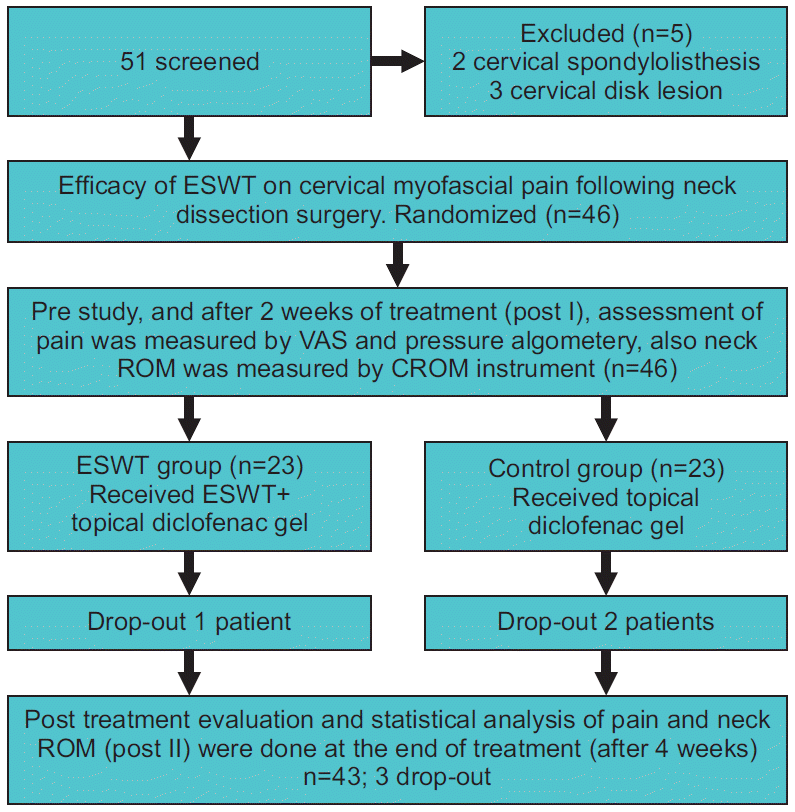1. Burusapat C, Jarungroongruangchai W, Charoenpitakchai M. Prognostic factors of cervical node status in head and neck squamous cell carcinoma. World J Surg Oncol. 2015; 13:51.

2. Pugazhendi SK, Thangaswamy V, Venkatasetty A, Thambiah L. The functional neck dissection for lymph node neck metastasis in oral carcinoma. J Pharm Bioallied Sci. 2012; 4(Suppl 2):S245–7.

3. Ferlito A, Robbins KT, Shah JP, Medina JE, Silver CE, Al-Tamimi S, et al. Proposal for a rational classification of neck dissections. Head Neck. 2011; 33:445–50.
4. Van Wilgen CP, Dijkstra PU, van der Laan BF, Plukker JT, Roodenburg JL. Morbidity of the neck after head and neck cancer therapy. Head Neck. 2004; 26:785–91.

5. Guru K, Manoor UK, Supe SS. A comprehensive review of head and neck cancer rehabilitation: physical therapy perspectives. Indian J Palliat Care. 2012; 18:87–97.

6. Sist T, Miner M, Lema M. Characteristics of postradical neck pain syndrome: a report of 25 cases. J Pain Symptom Manage. 1999; 18:95–102.
7. Bron C, Dommerholt JD. Etiology of myofascial trigger points. Curr Pain Headache Rep. 2012; 16:439–44.

8. Koca I, Boyaci A. A new insight into the management of myofascial pain syndrome. Gaziantep Med J. 2014; 20107–12.

9. Han TR, Bang MS. Myofascial pain. In : Kang YK, editor. Rehabilitation medicine. 3rd ed. Seoul, Korea: Koonja;2008. p. 887–96.
10. Cardoso LR, Rizzo CC, de Oliveira CZ, dos Santos CR, Carvalho AL. Myofascial pain syndrome after head and neck cancer treatment: prevalence, risk factors, and influence on quality of life. Head Neck. 2015; 37:1733–7.

11. Desai MJ, Saini V, Saini S. Myofascial pain syndrome: a treatment review. Pain Ther. 2013; 2:21–36.

12. Schmitz C, Csaszar NB, Rompe JD, Chaves H, Furia JP. Treatment of chronic plantar fasciopathy with extracorporeal shock waves (review). J Orthop Surg Res. 2013; 8:31.

13. Ioppolo F, Rompe JD, Furia JP, Cacchio A. Clinical application of shock wave therapy (SW T) in musculoskeletal disorders. Eur J Phys Rehabil Med. 2014; 50:217–30.
14. Speed C. A systematic review of shockwave therapies in soft tissue conditions: focusing on the evidence. Br J Sports Med. 2014; 48:1538–42.
15. Gleitz M. Myofascial syndrome and trigger points. Heilbronn, Germany: Level 10 Book;2011.
16. Ramon S, Gleitz M, Hernandez L, Romero LD. Update on the efficacy of extracorporeal shockwave treatment for myofascial pain syndrome and fibromyalgia. Int J Surg. 2015; 24(Pt B):201–6.

17. Schmitz C, Csaszar NB, Milz S, Schieker M, Maffulli N, Rompe JD, et al. Efficacy and safety of extracorporeal shock wave therapy for orthopedic conditions: a systematic review on studies listed in the PEDro database. Br Med Bull. 2015; 116:115–38.

18. Gleitz M, Hornig K. Trigger points: Diagnosis and treatment concepts with special reference to extracorporeal shockwaves. Orthopade. 2012; 41:113–25.
19. Suputtitada A. Novel approaches for chronic pain. Int J Phys Med Rehabil. 2016; 4:350.

20. Saggini R, Di Stefano A, Saggini A, Bellomo RG. Clinical application of shock wave therapy in musculoskeletal disorders: part II related to myofascial and nerve apparatus. J Biol Regul Homeost Agents. 2015; 29:771–85.
21. Wang CJ. Extracorporeal shockwave therapy in musculoskeletal disorders. J Orthop Surg Res. 2012; 7:11.

22. Notarnicola A, Moretti B. The biological effects of extracorporeal shock wave therapy (ESWT) on tendon tissue. Muscles Ligaments Tendons J. 2012; 2:33–7.
23. Zhang D, Kearney CJ, Cheriyan T, Schmid TM, Spector M. Extracorporeal shockwave-induced expression of lubricin in tendons and septa. Cell Tissue Res. 2011; 346:255–62.

24. Romeo P, Lavanga V, Pagani D, Sansone V. Extracorporeal shock wave therapy in musculoskeletal disorders: a review. Med Princ Pract. 2014; 23:7–13.

25. Hausdorf J, Lemmens MA, Heck KD, Grolms N, Korr H, Kertschanska S, et al. Selective loss of unmyelinated nerve fibers after extracorporeal shockwave application to the musculoskeletal system. Neuroscience. 2008; 155:138–44.

26. Travell JG, Simons DG, Simons LS. Myofascial pain and dysfunction: the trigger point manual (Vol. 1). 2nd ed. Baltimore, MD: Lippincott Williams & Wilkins;1999.
27. Faul F, Erdfelder E, Buchner A, Lang AG. Statistical power analyses using G*Power 3.1: tests for correlation and regression analyses. Behav Res Methods. 2009; 41:1149–60.

28. Suputtitada A. Update of extracorporeal shockwave therapy in myofascial pain syndrome. Int Phys Med Rehab J. 2017; 1:00019.

29. Ji HM, Kim HJ, Han SJ. Extracorporeal shock wave therapy in myofascial pain syndrome of upper trapezius. Ann Rehabil Med. 2012; 36:675–80.

30. Jeon JH, Jung YJ, Lee JY, Choi JS, Mun JH, Park WY, et al. The effect of extracorporeal shock wave therapy on myofascial pain syndrome. Ann Rehabil Med. 2012; 36:665–74.

31. Park KD, Lee WY, Park MH, Ahn JK, Park Y. High- versus low-energy extracorporeal shock-wave therapy for myofascial pain syndrome of upper trapezius: a prospective randomized single blinded pilot study. Medicine (Baltimore). 2018; 97:e11432.
32. Gur A, Koca I, Karagullu H, Altindag O, Madenci E, Tutoglu A, et al. Comparison of the effectiveness of two different extracorporeal shock wave therapy regimens in the treatment of patients with myofascial pain syndrome. Arch Rheumatol. 2014; 29:186–93.

33. Gur A, Koca I, Karagullu H, Altindag O, Madenci E. Comparison of the efficacy of ultrasound and extracorporeal shock wave therapies in patients with myofascial pain syndrome: a randomized controlled study. J Musculoskelet Pain. 2013; 21:210–6.

34. Hong JO, Park JS, Jeon DG, Yoon WH, Park JH. Extracorporeal shock wave therapy versus trigger point injection in the treatment of myofascial pain syndrome in the quadratus lumborum. Ann Rehabil Med. 2017; 41:582–8.





 PDF
PDF Citation
Citation Print
Print




 XML Download
XML Download